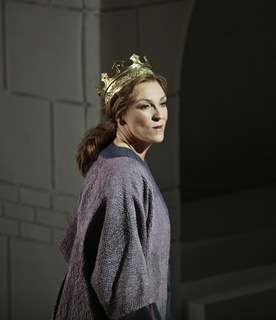|
Back
A Brechtian Tristan und Isolde Copenhagen
Operaen
05/10/2009 - & 13, 16, 21 May, 03, 07, 10*, 14 June
Richard Wagner: Tristan und Isolde
Johnny van Hal*/Stig Fogh Andersen (Tristan), Tina Kiberg/Irene Theoren* (Isolde), Randi Stene (Brangäne), Christian Christiansen*/Sten Byriel (King Marke), John Lundgren (Kurvenal), Peter Steen Andersen (Melot), Jens Bruno Hansen (Steersman), Michael Kristensen (Shepherd, Young Sailor)
Royal Opera Chorus, Philip White (Chorus Master), Royal Opera Orchestra, Jirí Kout (Conductor)
Stig Fogh Andersen (Director), Steffen Aarfing (Set Designer), Bob Katzenelson (Costume and Video Design), Mikael Sylvest (Lighting Design)

Tina Kiberg (© Per Morten Abrahamsen)
Copenhagen's Royal Danish Theatre (Det Kongelige Teater) is a protean organization dating from 1748 that now performs in three separate venues, all notable.
Its oldest theatre, now called the Old Stage (Gamle Scene), was built in 1847 and has been updated over the years. It seats about 1300 and is the main home of the Royal Danish Ballet. Some opera is still performed there, but its main venue is the Opera (or Operaen), completed in 2005. The third venue, for spoken theatre, is the Playhouse, completed in 2008. It contains three performing spaces (of 650, 200 and 100 seats) and occupies a waterfront location just opposite the Operaen.
The Operaen seats about 1500 on four levels and has the capacious pit and backstage areas one would expect from such a high-profile (and high budget) building. (Another notable fact: the entire cost of over 300 million euros was paid for by Denmark's richest family, who control the Maersk shipping firm. It is thus fitting that it occupies a site with sweeping views of Copenhagen's harbour.)
Perhaps the most notable fact about this new production of Tristan is that is also directed by one of its principals, namely Stig Fogh Andersen (who performed in the second and third of the eight performances). One might suspect that he would succumb to the temptation to highlight his own role, but such is definitely not the case. He has chosen a Brechtian approach that keeps most of the characters on stage, out of character, even when they are not part of the action of the moment. Much of the acting they are required to do is minimal and their costumes are ordinary modern dress with a few (very few) theatrical embellishments - for example, King Marke puts on a crown when he steps forward the sing his reproachful lament.
One character is permited to emote dramatically and that is Brangäne. At first she seems to be directing the action when she signals the steersman to put on his seaman's cap and proclaim his opening lines, but this thread is not followed. In Act II she is the one who acts out the passion expressed in the love duet and her final cry of warning is an orgasmic shriek.
The three-level unit set is also anti-dramatic, consisting of a semi-circle of structural stone elements and a skeletal metal stairway that almost looks nautical (suggesting the setting of the first act) and provides a degree of visual variety for chracters' entrances and placement. A video projection of trees makes a feeble stab at creating the setting for Act II. Normally in Act II there is an outburst of violence resulting in the death of Melot and Kurwenal, neither happens here. Alas, strangely, while a singer, Michael Kristensen, is credited with the shepherd's role. It was simply not sung at the performance I attended - a missed cue?
The main casualty of this non-dramatic approach is the Tristan, Johnny van Hal. He is required to linger interminably around the edge of the stage, looking hang-dog, and this only serves to dissipate whatever dramatic energy he might have brought to the role. Another problem is that vocally he doesn't meet the usual expectations for a Tristan in that he is a tenor without the baritonal heft that seems to be a requirement for the part. His voice is not unattractive or reedy or unsteady, and he maintains his tone and stamina throughout the punishing delerium of Act III. He would surely have made a better impression in a more appropriately directed production.
Irene Theoren is one performer who manages to compensate for the dramatic flatness of the concept by using her voice in a most expressive way. In Act II, for example, she expresses the required degree of anguish and concern at her entrance even though she strolls on to the stage one level above where Tristan lies. Her Liebestod is beautifully sung and a fitting climax for a performance that overall (orchestrally and vocally) is musically varied and expertly shaped.
Randi Stene is an full-voiced Brangäne and John Lundgren an expressive Kurwenal. Christian Christiansen brings a cavernous voice to the role of King Marke. The smaller roles are strongly sung and the men's chorus a model of virility.
The Royal Opera Orchestra (or Det Kingelige Kapel) which on many evenings is required to perform in two different theatres, has 126 listed members and about 85 of them perform for this Tristan. Jirí Kout's conducting emphasizes transparency; various instrumental solos are highlights of the performance.
A Brechtian approach can (and ought to) give a piece an extra dramatic edge. In this case, sadly, the results are decidedly anhedonic. This is a pity when the performance is musically so accomplished.
The Royal Danish Theatre
Michael Johnson
|